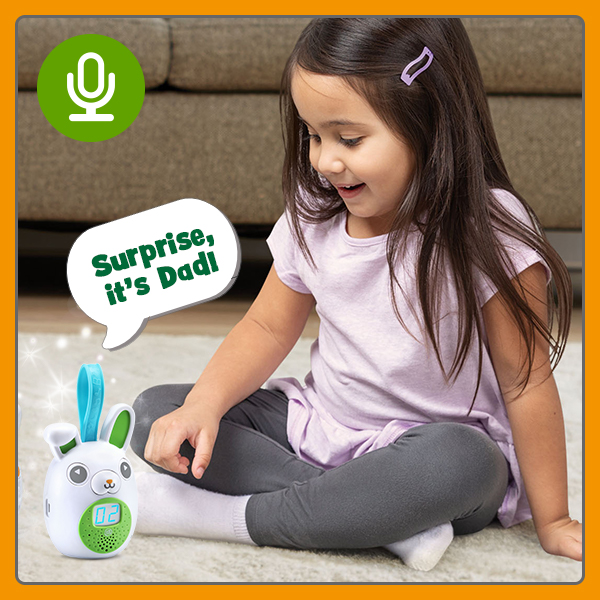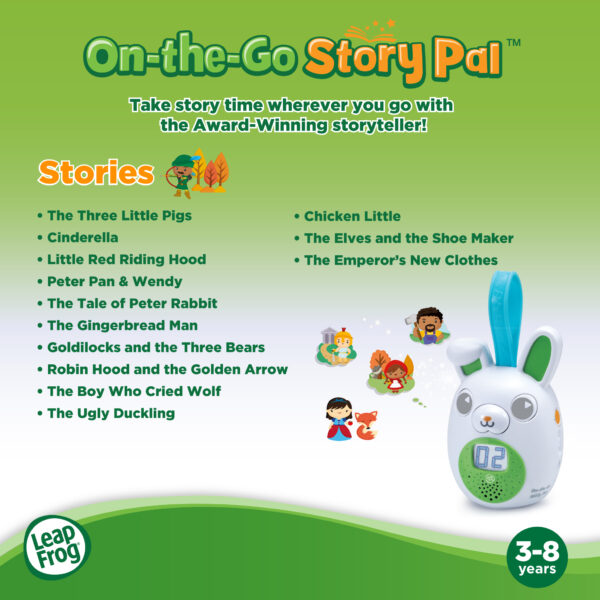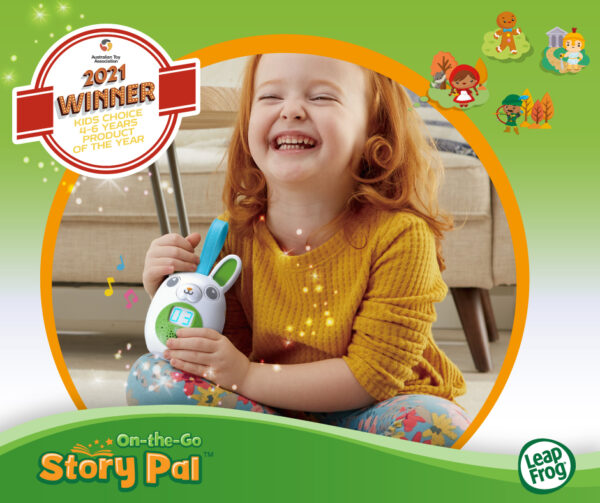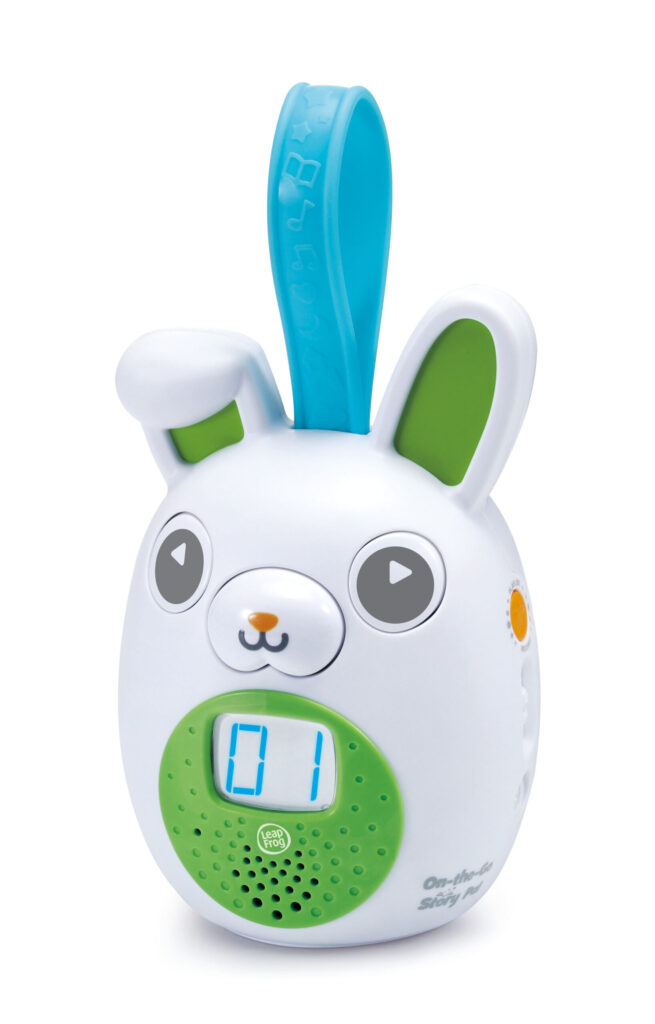Media kindly brought to you by LeapFrog
Storytime is a hallmark of childhood. No doubt, you’ll have memories of a favourite book, fairy tale or real-life story – perhaps one of many – that were shared with you as a child, and which enriched your understanding of the world and its possibilities. The gift of storytelling cannot be overstated, so it’s important to nurture an appetite for stories and socialise your child to different characters and plots. Doing so will aid your child’s brain development as they learn to process different perspectives, motivations and experiences, and turbocharge their sense of imagination.
So, how can mums and dads start a tradition of regular storytime that keeps their child engaged? While some children will take to storytime easier than others, it can be a challenge for all parents at one stage or another in balancing entertainment and learning. Thankfully, there are a number of strategies to keep your child captivated by storytime and help set the tone for a healthy relationship with reading and writing in later childhood, and as young adults.
Towards getting the most out of storytime with your child, we reached out to VTech Electronics- the leader in electronic, educational toys and maker of the popular LeapFrog series of toys and games, to share their advice for storytelling success. Since 1995, they’ve been entertaining and teaching a new generation of children through play, and have recently launched a new award-winning product – On-the-Go Story Pal® – which puts a new spin on classic storytelling! Let’s dive into some top tips to make storytelling a meaningful and memorable experience.

Align storytelling to your child’s interests
Storytelling has been described as “the interactive art of using words and actions to reveal the elements and images of a story while encouraging the listener’s imagination” [source]. It’s multifaceted and can involve many aspects of human expression but is always driven by stimulating the mind of a listener. Just like adults, kids will find certain story themes resonate better than others, and when the shortened attention span of a younger child comes into play, parents should take note. Especially as you introduce them to new storytelling rituals, observe what themes work (and which don’t), and try to appeal to their preferences in relation to favourite topics, characters and scenarios. Once you have established their appetite for storytelling, you can of course start to move beyond their comfort zone.

Dedicate time for storytelling
It’s the obvious yet sometimes overlooked first step, and is key to unlocking your child’s imagination, perspective-sharing and confidence to express themselves in story form. It’s been said that “storytelling is a human pursuit that crosses all cultures and generations and can help restore some of the missing elements in our children’s lives today” [source]. Reflecting on our current road to recovery from the pandemic, there’s never been a better time to engage your child through storytelling and renew their sense of hope and social connectedness.
Child development experts agree that storytelling promotes cognitive development, instils creativity and imagination, develops language and emotional maturity, and strengthens relationships [source] – but it can take some time to ‘stick’ with your child. Whether you’re reading from a book or delivering an impromptu story, watch if your child’s interest starts to wane, and consider breaking the story into more manageable chunks (a few pages per day, in the case of a book, to build anticipation). You could also try role modelling storytelling with other members in the family, to boost their enthusiasm. Storytime done in the home is important for reinforcing what they’re learning in preschool or early years of primary school. In the case of a favourite book, test when they’re ready to try reading parts aloud with you, to nurture literacy skills and set them up for good reading habits.

Choose different reading/storytelling locations
While bedtime may remain the quintessential setting for stories in the home, it’s a good idea to expand storytelling as an ‘anywhere and anytime’ activity without limitations. Taking a book to sit outside under a tree for instance or telling a story to pass the time during quieter moments on a family vacation. These new settings in themselves inspire story creation, helping kids make linkages to people, places and situations. Adventure-based stories happen to be a favourite for many kids – allowing them to explore different lands that they couldn’t otherwise. If you can mimic the setting of a story to some degree – reading ‘Treasure Island’ at the beach, for example – it’ll provide a more sensory experience, to help bring stories to life for your child.
Wouldn’t it be wonderful to have a mobile library of sorts, with stories in easy reach for when the mood strikes? With LeapFrog’s On-the-Go Story Pal player, kids aged 3-8 can take story time with them wherever they go! Designed to build a love of storytelling and develop pre-reading skills, the On-the-Go Story Pal® is preloaded with 30+ stories, poems, songs and lullabies to keep them entertained, including a handy carrying strap.

Co-create and encourage kids to craft their own stories
Storytelling is inherently interactive, where “the responses of the listeners influence the telling of the story” [source]. So, while it’s important for kids to listen to existing stories to understand the basic blueprint or structure of a story, parents should look at age-appropriate opportunities for story co-creation, to make kids a more active participant. Creativity and problem-solving skills are just the beginning for your budding storyteller!
Child development experts point to the power of storytelling and their healing effect: “Parents can help restore their children’s sense of self and belonging through storytelling activities…help[ing] build children’s self-esteem by eliciting stories from them that position the child as the hero.” For older children of reading age, ‘choose-your-own-adventure’ style of books often hold great appeal by empowering their decision making in the outcome of a story. For younger children, verbalising their own version of events will be similarly empowering.
When co-creating a story together, guide them on trying to include all the elements of a fully formed narrative, adjusted to their maturity level:
- Pick a main setting – place and time
- Determine a catalyst or ‘problem-starting’ event
- Introduce characters – reactions, motives and plans
- Describe the attempt(s) to solve the problem
- Explore the consequences
- Find a resolution, aka ‘happier ending’.
Once you’ve planned out your story, why not grab On-the-Go Story Pal® to ‘publish’ their creation?! On-the-Go Story Pal works by recording your own voice and creating your own personalised story. Make a playlist of up to five songs, poems or lullabies. Easy-to-navigate controls make it kid-friendly and simple to use, so they’re not just relying on you to commence the storytelling.

Try different formats and add a performative element
Books are rightfully a fixture of storytelling, but an exclusive reliance on them means that kids miss out on other formats of narrative. Lyrics-based music or plays, for instance, also count as telling a compelling story. Keep in mind that words – written or verbalised – are the tools of the trade for a storyteller, and that engaging children in oral-based storytelling (minus a printed or scripted book) is an effective way to build their vocabulary and broader oral language development. This premise is the basis of performance arts! And before you get all nervous about filling the shoes of a performer or playwright, remember that a little sprinkle of personality is all that’s needed to help bring those words to life for your child.
Acting out or role-playing scenes from a book can help your child make associations with characters and is great, full-bodied fun at the same time. Why not piggyback off their favourite tv shows to make a ‘new episode’ and extend the life of those already beloved stories?
Here are some educator-approved tips for a more sensory storytelling experience with children:
- use your voice to support children’s ability to construct meaning
- use changes in your pitch (voice highs and lows), tempo (speed), and rhythm
- show changes in the emotions of characters as situations develop
- use pitch and speed to build suspense and enhance the story’s meaning
[source]
Want some help? Performance of words for the ultimate sensory experience, is where LeapFrog’s On-the-Go Story Pal especially shines. The narrators’ voices, sound effects and content encourage listening comprehension and build a foundation for a love of storytelling.

Pulling it all together with Leapfrog’s On-the-Go Story Pal®
As we have explored above, On-the-Go Story Pal® supports storytime with preschool and early primary school kids in so many ways. In fact, it is an Australian Toy Association 2021 Award Winner, as per ‘Kids Choice’ (4-6 years) for Product of the Year! In addition to the 30+ preloaded stories, poems, songs and lullabies, there is free additional content available for download from the LeapFrog Learning Centre, featuring four packs of additional stories and music.
If you’re searching for the perfect gift to instill a passion for storytelling this holiday season, look no further than On-the-Go Story Pal® and the other awesome toy activities from VTech’s LeapFrog range.









